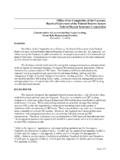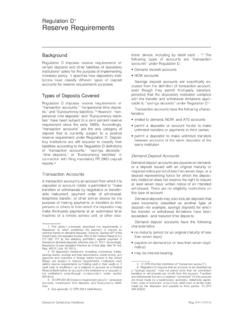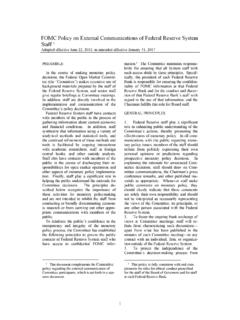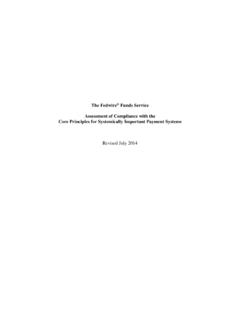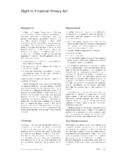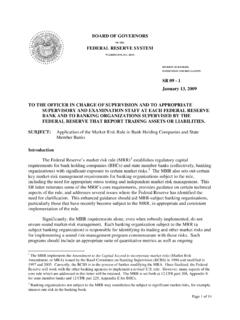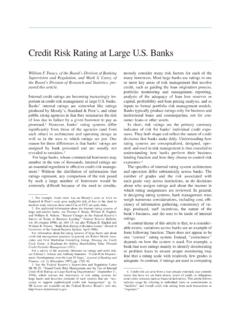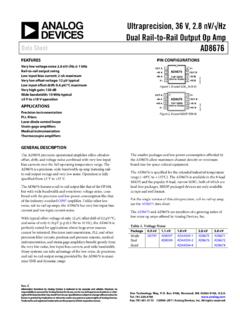Transcription of FEDERAL RESERVE statistical release
1 FEDERAL RESERVE statistical release (419) For release at 9:15 (EST). February 15, 2018. INDUSTRIAL PRODUCTION AND CAPACITY UTILIZATION. Industrial production edged down percent in January following four consecutive monthly increases. Manufacturing production was unchanged in January. Mining output fell percent, with all of its major component industries recording declines, while the index for utilities moved up percent. At percent of (over). Industrial Production and Capacity Utilization: Summary Seasonally adjusted 2012=100 Percent change 2017 2018 2017 2018 Jan. '17 to Industrial production Jan. '18. Total index.
2 2 .3 .4 Previous estimates .2 .9. Major market groups Final Products .0 .5 .6 .4 Consumer goods .0 .1 .3 Business equipment .0 .9 Nonindustrial supplies .5 .9 .4 .0 .7. Construction .5 .8 .5 .9. Materials .9 .4 Major industry groups Manufacturing (see note below) .2 .2 .0 .0 Previous estimates .1 .3 .1. Mining Utilities .6 Capacity Percent of capacity growth Average 1988- 1990- 1994- 1972- 89 91 95 2009 2017 2017 2018 Jan. '17 to Capacity utilization 2017 high low high low Jan. Jan. '18. Total industry Previous estimates Manufacturing (see note below) .7. Previous estimates Mining Utilities .8. Stage-of-process groups Crude Primary and semifinished.
3 6. Finished .9. r Revised. p Preliminary. Note. The statistics in this release cover output , capacity, and capacity utilization in the industrial sector, which is defined by the FEDERAL RESERVE to comprise manufacturing, mining, and electric and gas utilities. Mining is defined as all industries in sector 21 of the North American Industry Classification System (NAICS);. electric and gas utilities are those in NAICS sectors 2211 and 2212. Manufacturing comprises NAICS manufacturing industries (sector 31-33) plus the logging industry and the newspaper, periodical, book, and directory publishing industries. Logging and publishing are classified elsewhere in NAICS (under agriculture and information, respectively), but historically they were considered to be manufacturing and were included in the industrial sector under the Standard Industrial Classification (SIC).
4 System. In December 2002 the FEDERAL RESERVE reclassified all its industrial output data from the SIC system to NAICS. 1. its 2012 average, total industrial production was percent higher in January than it was a year earlier. Capacity utilization for the industrial sector fell percentage point in January to percent, a rate that is percentage points below its long-run (1972 2017) average. Market Groups In January, the output of consumer goods moved up percent; much of the gain reflected an increase of percent for consumer energy products. The output of durable consumer goods rose about 1/2 percent, while the output of non-energy nondurables was unchanged.
5 Business equipment registered a gain of percent mostly as a result of advances of percent or more posted by information processing equipment and by industrial and other equipment. The index for defense and space equipment slipped percent after having increased in six of the previous seven months. The output of construction supplies dropped percent, while the index for business supplies fell back percent. The production of materials moved down percent, with consumer parts and paper materials posting drops that were greater than 1 percent. Industry Groups Manufacturing output was unchanged in January for a second consecutive month; the index has increased percent over the past 12 months.
6 Major manufacturing industries recorded a broad mix of gains and losses in January. The production of durables moved up percent, and the index for nondurables was unchanged. The output of other manufacturing (publishing and logging) fell percent. In January, the output of mining declined percent for a second consecutive monthly loss. Even so, the mining index for January was percent higher than its year-earlier level because of strength in the oil and natural gas sector. Capacity utilization for manufacturing was unchanged in January at percent, a rate that is percentage points below its long-run average.
7 The operating rate for durables, at percent, was less than 1 percentage point below its long-run average, whereas the rates for nondurables and for other manufacturing (publishing and logging), at percent and percent, respectively, were further below their long-run averages of about 80 percent for each. Utilization for mining fell percentage points to percent, but the rate for utilities rose percentage point to percent. Capacity utilization rates for both mining and utilities remained below their long-run averages. Note: Preliminary Estimates of Industrial Capacity The data in this release include preliminary estimates of industrial capacity for 2018.
8 Measured from fourth quarter to fourth quarter, total industrial capacity is projected to rise percent this year after increasing percent in 2017. Manufacturing capacity is expected to advance percent in 2018, somewhat faster than the percent pace in 2017. Capacity in the mining sector is estimated to rise percent in 2018 following a smaller increase of percent in 2017. Capacity at electric and natural gas utilities is projected to increase percent in 2018 after moving up percent in 2017. 2. Tables 1. Industrial Production: Market and Industry Group Summary; percent change 2. Industrial Production: Special Aggregates and Selected Detail; percent change 3.
9 Motor Vehicle Assemblies 4. Industrial Production: Market and Industry Group Summary; indexes 5. Industrial Production: Special Aggregates and Selected Detail; indexes 6. Diffusion Indexes of Industrial Production 7. Capacity Utilization 8. Industrial Capacity 9. Gross Value of Final Products and Nonindustrial Supplies 10. Gross-Value-Weighted Industrial Production: Stage-of-Process Groups 11. Historical Statistics: Total Industry 12. Historical Statistics: Manufacturing 13. Historical Statistics: Total Industry Excluding Selected High-Technology Industries 14. Historical Statistics: Manufacturing Excluding Selected High-Technology Industries 15.
10 Industrial Production: Reliability Estimates Further detail is available on the Board's website ( ). Revision of Industrial Production and Capacity Utilization The FEDERAL RESERVE Board plans to issue its annual revision to the index of industrial pro- duction (IP) and the related measures of capacity utilization on March 23, 2018. New annual benchmark data for 2016 for manufacturing will be incorporated, as will other annual data , includ- ing information on the mining of metallic and nonmetallic minerals (except fuels). The updated IP indexes will include revisions to the monthly indicator (either product data or input data ) and to seasonal factors for each industry.
